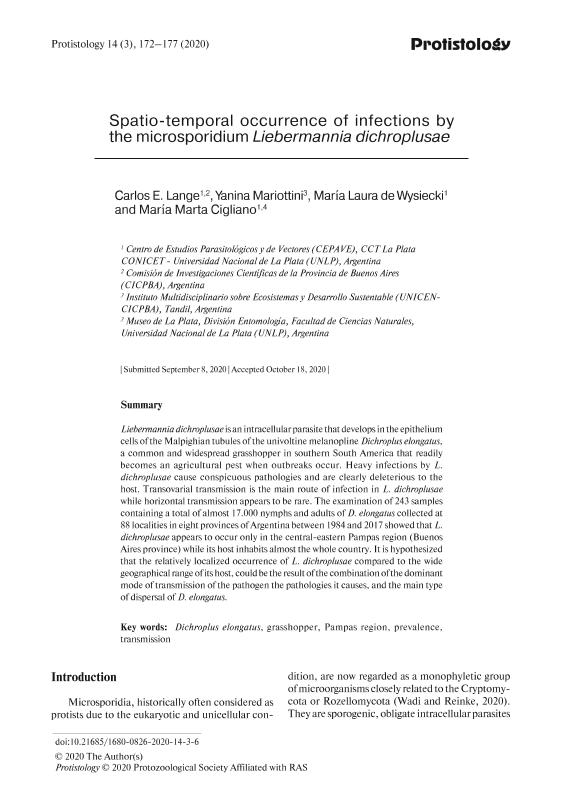Artículo
Spatio-temporal occurrence of infections by the microsporidium liebermannia dichroplusae
Fecha de publicación:
2020
Editorial:
Protozoological Society Affiliated With The Russian Academy Of Sciences
Revista:
Protistology
ISSN:
1680-0826
Idioma:
Inglés
Tipo de recurso:
Artículo publicado
Clasificación temática:
Resumen
Liebermannia dichroplusae is an intracellular parasite that develops in the epithelium cells of the Malpighian tubules of the univoltine melanopline Dichroplus elongatus, a common and widespread grasshopper in southern South America that readily becomes an agricultural pest when outbreaks occur. Heavy infections by L. dichroplusae cause conspicuous pathologies and are clearly deleterious to the host. Transovarial transmission is the main route of infection in L. dichroplusae while horizontal transmission appears to be rare. The examination of 243 samples containing a total of almost 17.000 nymphs and adults of D. elongatus collected at 88 localities in eight provinces of Argentina between 1984 and 2017 showed that L. dichroplusae appears to occur only in the central-eastern Pampas region (Buenos Aires province) while its host inhabits almost the whole country. It is hypothesized that the relatively localized occurrence of L. dichroplusae compared to the wide geographical range of its host, could be the result of the combination of the dominant mode of transmission of the pathogen the pathologies it causes, and the main type of dispersal of D. elongatus.
Palabras clave:
DICHROPLUS ELONGATUS
,
GRASSHOPPER
,
PAMPAS REGION
,
PREVALENCE
,
TRANSMISSION
Archivos asociados
Licencia
Identificadores
Colecciones
Articulos(CEPAVE)
Articulos de CENTRO DE EST.PARASITOL.Y DE VECTORES (I)
Articulos de CENTRO DE EST.PARASITOL.Y DE VECTORES (I)
Citación
Lange, Carlos Ernesto; Mariottini, Yanina; de Wysiecki, Maria Laura; Cigliano, Maria Marta; Spatio-temporal occurrence of infections by the microsporidium liebermannia dichroplusae; Protozoological Society Affiliated With The Russian Academy Of Sciences; Protistology; 14; 3; 2020; 172-177
Compartir
Altmétricas




